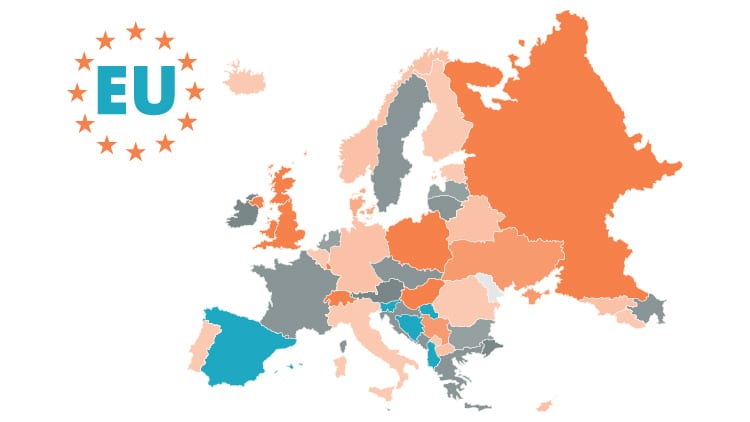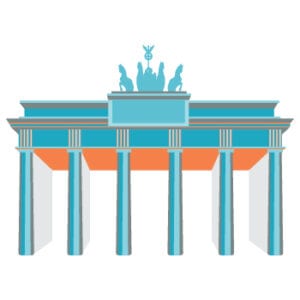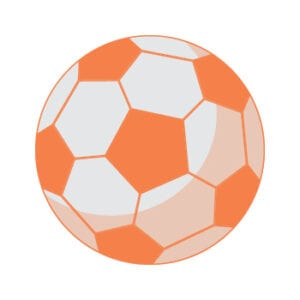Which European language has most native speakers

.

Europe:
The world is divided into seven continents. The linguistic and cultural trends of every continent are different. Each continent has had to go through many changes as different states got their independence. The Europe of today has 51 independent states. There is cultural and linguistic overlap between various countries of the continent. The countries have formed the European Union to promote cooperation between them and to facilitate their citizens. The travel and study conditions in every European country for European citizens are very favorable. Even the linguistic differences between countries have not been a problem because of frequent overlap.
The Languages of Europe:
The majority of languages spoken on the continent belong to the Indo-European family. Nearly 94% of Europe’s population speaks one of the Indo-European languages. From the Indo-European family, Romance languages, Germanic languages, and Slavic languages have the highest number of speakers in Europe. The Latin alphabet is used to write a significant percentage of the languages of Europe.
Turkic and Uralic languages are the most popular non-Indo-European groups in Europe. Russian, English, German, French, and Italian have more than fifty million speakers on the continent. English is not restricted to one or two countries of the continent. It has speakers in almost every country. It is also one of the 24 official languages of the European Union.
Foreign languages are not very popular in Europe. The immigrants who move to a European country learn the official language of that state. Some of them continue to speak their mother tongue in their homes, but they use the national language outside. Some foreign languages spoken in Europe belong to the Semitic language group, while others are Indo-Aryan, Baltic, Albanian, and Celtic.


Which European Language Has the Most Native Speakers?
The speakers of every popular language can be found in different countries. Many European languages are spoken by millions of speakers around the world. Spanish, French, Portuguese, and English have millions of native speakers in the Americas and Africa. They are also the official languages of dozens of countries. However, in Europe, most of them have less than 100 million native speakers. As a result, they are treated as just national languages.
The European language with the most native speakers on the continent is Russian. The Russian language has more than 100 million native speakers in Europe. But Russian is not the only Slavic tongue spoken in Europe. The speakers of Slavic languages can be found in Southern, Central, and Eastern Europe. Polish, Ukrainian, and Serbo-Croatian are the most popular Slavic languages in Europe after Russian.
Although English is the most spoken language on the continent, it does not have a lot of native speakers. It is spoken as a second or foreign language by 200 million people. Out of the Germanic languages, it is German that has the highest number of native speakers. Scandinavian languages, Swedish, Danish, and Norwegian, belong to the North Germanic group and have 10, 6, and 5 million speakers respectively.
Romance languages make up another popular group in Europe. They are the daughter languages of Latin. They are spoken natively by more than 200 million Europeans. With 72 million speakers, French is the most popular of all the Romance languages. Italian is on the second number with 65 million speakers. Spanish, which is the most popular Romance language outside of Europe, is spoken by 40 million people.
Plenty of other Indo-European languages are spoken by small communities in Western and Eastern Europe. Some of them are Modern Greek, Albanian, Baltic languages, Indo-Aryan languages, and Celtic languages. The linguistic diversity of the European population is quite remarkable.
If you ask most people what is the most popular or most spoken European language, they won’t be able to give the correct answer. For many people, one of the more popular Indo European languages like English or Spanish would have the most number of speakers. Although both English and Spanish are official languages of multiple countries, they are not natively spoken by the majority in Europe. However, it is Indo-European languages that still rule the linguistic trends on this continent.
Russian Language:
Russian is an East Slavic language which is written in the Cyrillic alphabet. It is primarily spoken in eastern European regions. There are only four living members of the East Slavic languages group and Russian is one of them. It is used throughout the Baltic states. No study of languages can be completed without doing a complete analysis of the Russian tongue.
Although it is one of the Indo-European languages, Russian does not share a lot of features with other members of the family. It does not have any similarity with Germanic languages. But after coming in contact with other European tongues, it has adopted some of their words. The foreign languages that Russia has adopted words include French, Italian, English, German, Polish, and Dutch. Russian has also influenced the languages of European countries. Several words of the vernacular have made it into the popular tongues of Europe.
Russian has several dialects but the most popular is the one that is spoken in Moscow. It is the Moscow dialect that the students of Slavic languages focus on. Attempts have been made for the Romanization of the Russian language. In the modern period, romanization has become better, and several keyboards have been launched with the new Russian writing system.
Russian is an East Slavic language which is written in the Cyrillic alphabet. It is primarily spoken in eastern European regions. There are only four living members of the East Slavic languages group and Russian is one of them. It is used throughout the Baltic states. No study of languages can be completed without doing a complete analysis of the Russian tongue.
Although it is one of the Indo-European languages, Russian does not share a lot of features with other members of the family. It does not have any similarity with Germanic languages. But after coming in contact with other European tongues, it has adopted some of their words. The foreign languages that Russia has adopted words include French, Italian, English, German, Polish, and Dutch. Russian has also influenced the languages of European countries. Several words of the vernacular have made it into the popular tongues of Europe.
Russian has several dialects but the most popular is the one that is spoken in Moscow. It is the Moscow dialect that the students of Slavic languages focus on. Attempts have been made for the Romanization of the Russian language. In the modern period, romanization has become better, and several keyboards have been launched with the new Russian writing system.

What Is the Most Important Indo-European Language?
There are many members of the Indo-European family that are known all over the world. But some of them are more important in Europe than others. The German language, which belongs to the West Germanic branch of the Indo-Euro
pean family is one of the most important languages in the business world today. The economic position of Germany has made its language popular in the corporate sector.
The English language, which also belongs to the West Germanic branch, is another popular tongue from Europe. You can find English speakers in every country of the world. No list of languages can be complete without the English language. It is also very popular in Europe. In many regions, it is the lingua franca of the European population.
Spanish, the daughter language of Latin, is another very important tongue. It is one of the many Romance languages that are spoken in different parts of the world. Spain, the home of the Spanish language, is where many tongues originated throughout history.
Scandinavian languages that are spoken in Northern Europe are also very important. They have historical value. They originated from the Norse language, which was spoken by the Vikings. One interesting thing about these tongues is that they are mutually intelligible. Norwegian language speakers can understand Swedish speakers and vice versa.
Europe is also home to several indigenous languages. Scottish Gaelic is one such language which is spoken by at least half a million people as their mother tongue. It is impossible to declare one Indo-European language as the most important one. They all have their own features that make them important in some way. But it is true that German and English speakers get a more warm welcome in the corporate world. As long as you know one of the most spoken tongues, you won’t have a problem getting around Europe.





